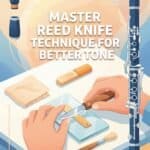How to make a clarinet reed: materials, tools, and 7 clear steps
To make a clarinet reed, start with well aged Arundo donax cane, a reed knife, cutting block, sandpaper, and a plaque. Cut and shape the blank, thin the tip and heart, balance the back, then soak, finish, and test on your clarinet. Refine with light scraping until response and tone feel even and stable.
What is reed making? A concise definition and outcome
Reed making is the craft of turning raw cane into a playable clarinet reed with controlled thickness, shape, and flexibility. The goal is a reed that vibrates evenly, responds quickly, and produces a stable, centered tone. Good reed making gives you control over strength, resistance, and color so you are not limited by inconsistent store bought reeds.
For clarinetists, reed making is both a technical and musical process. Each step, from selecting cane to final sanding, shapes how the reed interacts with the mouthpiece and air column. When done well, reed making lets you match reeds to your embouchure, setup, and repertoire, improving consistency across practice, rehearsal, and performance.
Why cane matters: Arundo donax and French cane characteristics
Clarinet reeds are traditionally made from Arundo donax, a giant cane species with long, straight fibers and strong yet flexible cell walls. Arundo donax from French growing regions, especially the Var and Gard, is prized for its density, fine grain, and balanced moisture behavior, all of which support stable vibration and clear sound.
French cane typically offers a tight, even grain that helps reeds respond quickly without collapsing under pressure. Its density supports a full, focused tone, while its natural elasticity allows subtle dynamic control. Compared with generic or ornamental cane, high quality Arundo donax tends to warp less, crack less, and hold its playing characteristics over more practice hours.
For reed makers, cane quality directly shapes the work required at the bench. Dense, even French cane allows thinner tips without losing support, and it tolerates fine adjustments with a knife or sandpaper. Poor quality cane often forces heavy corrections, produces dead spots in the sound, and may never settle into a reliable playing state.
Preparing cane: harvesting, aging (several months) and selection criteria
Reed making begins long before you pick up a knife. Harvest timing, aging, and selection all influence how the cane will behave under the blade and on the mouthpiece. Traditional practice favors winter harvesting, when Arundo donax sap content is lower and fibers are more stable for musical use.
After cutting, cane is typically split into tubes and air dried for several months to stabilize moisture and internal stresses. This aging period lets the cell walls harden and reach a workable balance between stiffness and flexibility. Rushing this step often leads to reeds that warp quickly or feel spongy and unresponsive, even with careful finishing.
When selecting cane for clarinet reeds, focus on straightness, wall thickness, and grain. Look for tubes with:
- Diameter close to your mouthpiece facing curve
- Even wall thickness, not too thin or excessively heavy
- Straight fibers with no visible twists, knots, or discoloration
- Fine, uniform grain without large pores or soft patches
Reject pieces with cracks, insect damage, or pronounced curvature. Even small defects can create leaks or weak zones in the finished reed. Good selection at this stage saves time later and increases the percentage of reeds that reach performance quality.
Tools & reed making kits: important equipment (cutters, knives, sandpaper) and setup
A practical reed making setup does not need to be complex, but tools must be sharp, stable, and safe. Many clarinetists start with a reed making kit, then add specialized tools as their skills grow. A clear, organized workspace helps you work accurately and repeat steps from reed to reed.
Core tools for clarinet reed making include:
- Reed knife or scraper: a sharp, flat or slightly curved blade for controlled shaving
- Cutting block: a hard, smooth surface to support the reed during trimming
- Reed guillotine or clipper: for cutting the tip to length
- Plaque: a thin metal or plastic insert to support the reed while scraping
- Sandpaper: fine grits (400 – 1000) for smoothing and micro adjustments
- Measuring tools: calipers or a thickness gauge for consistent dimensions
- Files: small flat or needle files for shaping the rails and heel
Arrange tools so the reed always rests on a stable surface when cutting. Keep blades sharp; dull knives crush fibers and cause chatter marks that weaken the tip. Many makers use a small magnifier or good task lighting to see grain details and subtle thickness changes, especially near the tip and heart.
Cutting and shaping techniques: tip, back, and thickness considerations
Understanding reed anatomy is important before you start cutting. A clarinet reed has several key zones: the tip, heart, back (or vamp), rails, and table. The cane grain runs lengthwise, and your goal is to thin these zones in a controlled way so the reed vibrates evenly without collapsing.
The tip is the thinnest area and starts the vibration. Typical clarinet tip thickness ranges from about 0.09 to 0.12 mm. The heart, just behind the tip, is thicker and carries most of the structural support, often around 0.30 to 0.40 mm. The back or vamp transitions from the heart to the thicker heel, shaping resistance and color.
Step 1: Cut the blank and flatten the table
Begin by splitting the cane tube into slips and planing or sanding the inner surface flat. This flat surface becomes the table that meets the mouthpiece. Aim for a smooth, even table with no hollows; irregularities here cause leaks and unstable response.
Trim the slip to clarinet reed width and approximate length. Use a template or an existing reed as a guide. Keep the grain straight along the length so the fibers support the vibration evenly from heel to tip.
Step 2: Profile the vamp and establish thickness zones
Next, thin the outer surface to create the vamp profile. Many makers remove more cane near the tip and sides while leaving a thicker central heart. Work gradually with a knife or profiling tool, checking thickness with a gauge if available.
A common approach is:
- Tip zone: very thin, for easy vibration and quick response
- Heart: thicker, centered, for stability and core tone
- Back: gradual increase in thickness toward the heel for support
Always cut along the grain, not across it, to avoid tearing fibers. Short, controlled strokes give more precision than long, sweeping cuts.
Step 3: Shape the tip and rails
Once the profile is close, use a reed guillotine or sharp knife to clip the tip to final length. Then refine the tip with very light scraping or fine sandpaper on a plaque. Aim for a smooth, even arc across the tip, with no flat spots or corners.
Shape the rails along the sides of the reed so they are slightly thinner than the center but still supportive. Uneven rails can cause the reed to favor one side, leading to asymmetrical response and tone. Check symmetry by holding the reed up to a light and comparing both sides of the vamp.
Step 4: Balance the back and heart
Finally, fine tune the back and heart. If the reed feels too stiff, remove tiny amounts from the back and outer heart, not just the tip. If it feels too soft or unstable, you may have thinned the heart too much and should leave more material in this zone on future reeds.
Throughout shaping, test flex by gently pressing the tip against a plaque. It should flex evenly without kinks or sudden soft spots. This mechanical check, combined with later play testing, helps you link thickness patterns to playing feel.
Soaking and break in: best practices for warm water soak and initial play
Cane responds strongly to moisture, so controlled soaking and break in are important for stable reeds. Dry cane is brittle and unresponsive, while over soaked cane can feel mushy and lose definition. A balanced approach helps the reed settle into its long term behavior.
Before first playing, soak the finished reed in warm, not hot, water for 2 to 5 minutes. Warm water penetrates the fibers more evenly than cold, softening the cane without shocking it. Blot excess water gently; do not rub the tip, which can fray the delicate fibers.
Break in the reed over several short sessions rather than a single long rehearsal. For example:
- Day 1: 5 to 10 minutes of light playing, mostly mid register
- Day 2: 10 to 15 minutes, adding more dynamics and range
- Day 3: 15 to 20 minutes, including louder passages and articulation
This gradual process lets the cane adjust to moisture cycles and mechanical stress, reducing the risk of sudden warping or early fatigue. After each session, allow the reed to dry on a flat, ventilated surface before storing it in a case with some humidity control.
Finishing, sealing and quality control: sanding, sealing, and testing on the clarinet
Finishing and quality control turn a shaped reed into a reliable musical tool. At this stage, you refine the surface, stabilize the cane, and test how the reed behaves on your actual clarinet and mouthpiece setup. Small, patient adjustments are more effective than large, hurried cuts.
Use fine sandpaper, often 600 to 1000 grit, to smooth the vamp and tip. Work from heel toward tip with light pressure, keeping the reed supported on a plaque or flat surface. The goal is to remove micro ridges and knife marks that can disturb vibration, not to change the overall profile dramatically.
Some makers lightly seal the back or heel with a thin coat of natural oil or shellac, avoiding the vibrating tip and heart. This can slow moisture exchange and reduce warping, especially in variable climates. If you experiment with sealing, apply sparingly and test how it affects response and tone on several reeds.
Quality control should include stepwise checks:
- Visual: symmetry of vamp and rails, clean tip, no cracks
- Mechanical: even flex across the tip, no soft spots
- Fit: stable seal on the mouthpiece table, secure ligature placement
- Playing: response at soft and loud dynamics, clarity in all registers, stable pitch
Play test at different dynamics and articulations. If the reed feels close but not perfect, mark areas to adjust with a pencil, remove the reed, and make tiny corrections with a knife or sandpaper. Repeat until the reed speaks easily, maintains a centered tone, and feels consistent from day to day.
Troubleshooting common reed problems and quick workshop fixes
Even with careful work, reeds can show problems like warping, cracking, weak response, or harsh tone. Systematic troubleshooting helps you decide whether to adjust, rework, or retire a reed. Linking specific symptoms to cane properties and shaping choices improves your next batch as well.
Problem: Reed is too hard or resistant
If the reed feels too stiff, especially in soft dynamics, check the heart and back. Often the tip is already thin enough. Lightly scrape or sand the outer edges of the heart and the upper back, keeping the center slightly thicker. Avoid over thinning the tip, which can make the sound edgy without solving resistance.
Problem: Reed is too soft or collapses at volume
A reed that feels too soft or shuts down at louder dynamics usually lacks support in the heart or back. In this case, there is limited room for correction. You can sometimes improve stability by very lightly thinning the extreme tip to free vibration while leaving the heart as is, but often this reveals that the cane or initial profile was too light.
Problem: Uneven response or tone between registers
If low notes are stuffy while high notes are bright, or vice versa, look for asymmetry. Hold the reed to the light and compare both sides of the vamp. Remove tiny amounts from the heavier side, especially along the rail and outer heart, until both sides flex and sound more evenly.
Problem: Warping and table leaks
Warping shows as a slight curve in the table, leading to leaks and unstable attacks. To address mild warping, lightly flatten the table on very fine sandpaper placed on glass or another flat surface. Move the reed in straight strokes, checking often. For severe warping, the cane may be unsuitable or insufficiently aged.
Problem: Cracks or tip fraying
Cracks, especially at the tip, usually cannot be repaired reliably. They often result from overly dry storage, rough handling, or defective cane. Tip fraying can sometimes be cleaned with very fine sandpaper or a sharp blade, but if fibers continue to separate, retire the reed and review your soaking and storage habits.
Maintenance and longevity: storage, rotation, and care for consistent sound
Good maintenance extends reed life and keeps your sound consistent over weeks instead of days. Even the best made reeds fatigue over time, but careful storage, rotation, and cleaning slow this process and protect your investment of time and effort.
Store reeds in a ventilated case that holds them flat and allows some air circulation. Cases with humidity control, such as a small sponge or commercial humidity pack, help avoid extremes that cause warping or cracking. Avoid leaving reeds on the mouthpiece between sessions, where they dry unevenly and collect residue.
Rotate several reeds in parallel. Many players keep 3 to 6 reeds in active use, playing each for a short period per day. This rotation allows reeds to rest and dry fully between uses, which helps them maintain their shape and strength longer than a single reed used constantly.
After playing, rinse the reed briefly in clean water to remove saliva and residue, then blot the table and lay it flat to dry before returning it to the case. Avoid touching or wiping the tip. Regularly inspect for mold or discoloration; discard any reed that shows persistent spots or odor despite cleaning.
By combining thoughtful reed making with disciplined maintenance, you gain a more predictable setup. Over time, you will learn how specific cane characteristics, shaping choices, and care routines translate into the response, tone, and reliability you want from your clarinet.
Key Takeaways
- Start with well aged, high quality Arundo donax cane, preferably with fine, even French style grain, to improve stability and tone.
- Control reed anatomy by managing tip, heart, and back thickness, using sharp tools and small, repeatable adjustments.
- Use warm water soaking, gradual break in, careful finishing, and consistent storage and rotation to extend reed life and keep your sound reliable.
FAQ
What is reed making?
Reed making is the process of turning raw cane into a playable clarinet reed through cutting, shaping, sanding, and finishing. The maker controls thickness and profile in zones like the tip and heart so the reed vibrates evenly, responds easily, and produces a stable, musical tone on the clarinet.
What type of cane is best for clarinet reeds?
The best cane for clarinet reeds is Arundo donax, especially from established French growing regions known for dense, fine grained stalks. This cane offers a strong yet flexible structure, good moisture behavior, and consistent grain, which together support reliable vibration, full tone, and longer lasting reeds.
What tools do I need to make a clarinet reed?
Core tools include a sharp reed knife, a cutting block, a reed guillotine or clipper, a plaque, and fine sandpaper. Many makers also use calipers or a thickness gauge, small files, and a flat surface such as glass for flattening the table. A simple reed making kit can cover most of these needs.
How long should cane age before shaping?
Cane should typically age for several months after harvesting before you start shaping reeds. This air drying period stabilizes moisture content and lets the fibers harden, improving flexibility and reducing warping. Some makers extend aging to a year or more for added stability, especially in variable climates.
Why does my reed warp or crack and how can I fix it?
Reeds warp or crack due to uneven drying, extreme humidity changes, or weak cane structure. Mild warping can be improved by lightly flattening the table on fine sandpaper and improving storage humidity. Cracks, especially at the tip, usually cannot be repaired reliably, so focus on better cane selection and gentler soaking and drying routines for future reeds.






